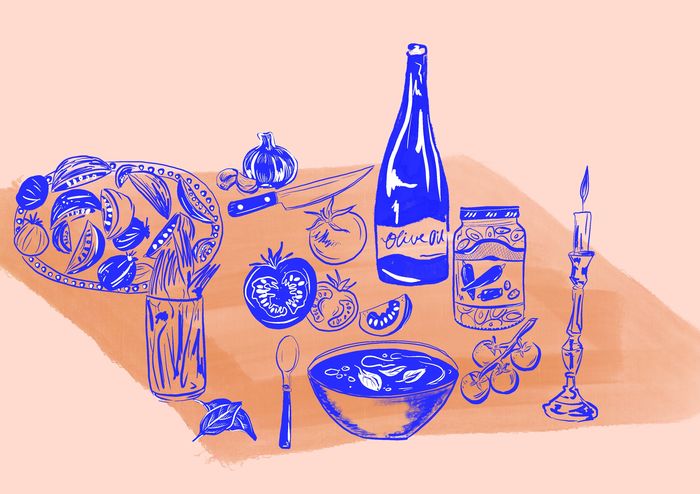Common threads: embroidery exhibitions at Kettle’s Yard and The Fitzwilliam Museum
Benjamin Knight unravels the social and political narratives in his joint review of the Palestinian Embroidery exhibition at Kettle’s Yard, and the Mediterranean Embroideries exhibition at The Fitzwilliam Museum

Walking down the ramp at Kettle’s Yard, you first see the beautiful patterns of embroidery from the room beyond before turning to an introductory video showing the processes of embroidery. Across three galleries, Material Power: Palestinian Embroidery, curated by Rachel Dedman, showcases the diversity of historical and contemporary Palestinian embroidery. Meanwhile, tucked away in the Fitzwilliam Museum’s Shiba Gallery, Deniz Türker’s Mediterranean Embroideries reaches across the Mediterranean basin, including Palestine.
Although both exhibits showcase the beauty of the embroideries that they contain, the two exhibits take different approaches to gallery text. Mediterranean Embroideries focuses on how regional exchange spreads materials and motifs while Material Power emphasises the social aspects of embroidery, reflecting on the continuation of embroidery traditions among colonised and displaced peoples.
Nevertheless, in both exhibits, the social importance of embroidery is present in the acts of embroidering, mending, and using, as well as the social meanings of patterns and motifs. See a 1930’s dress from Ramallah, found in the second gallery of Material Power. A patch in the central section of the torso and under both arms demonstrates how the dress has been repurposed to be worn by a taller individual, to whom the dress was given. This patch is not from the same material as the original but is instead repurposed from bags used to transport aid grain. Staining below the primary patch shows how the dress, while beautiful, also served as a functional object.
“We are encouraged to think about how motifs were given meaning and where those meanings originated”
The Ramallah dress demonstrates traditional patterns, largely determined by the location and social position of the embroiderer, who likely would have made the dress for herself as a stage in her coming of age. Elsewhere in the same gallery, dresses containing the Palestinian flag show more modern developments that embrace the distinctly political power of embroidery. As the Palestinian people were displaced by colonisation, occupation, and the formation of the Israeli state, traditional, localised patterns became less significant with simpler patterns taking their place. The Palestinian flag developed as a recurring motif in Palestinian embroidery amid suppression of Palestinian identity and displays of Palestinian nationalism. It could be worn and displayed as a motif with greater freedom than as a standalone object of protest and nationalist pride. This incorporation of the flag was not simply recreating the flag in embroidery but engaged with traditional patterns to incorporate it skilfully in ways that maintain the medium’s fusion of artistry and utility.
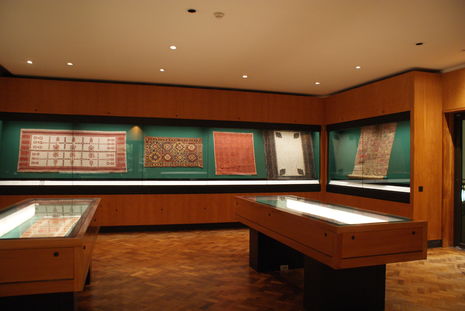
Material Power also includes a display of Palestinian resistance posters that draw upon the motifs and patterns of embroidery, incorporating the female voice into the Palestinian political narrative. Dedman carefully curates the exhibit to make clear the social and political importance of women’s labour—in preserving practices of embroidery and in representing national and regional identity through both subtle localised patterns and the more legible displays of the Palestinian flag. In this way, Material Power clearly presents embroidery as a socially and politically important process among the Palestinian people.
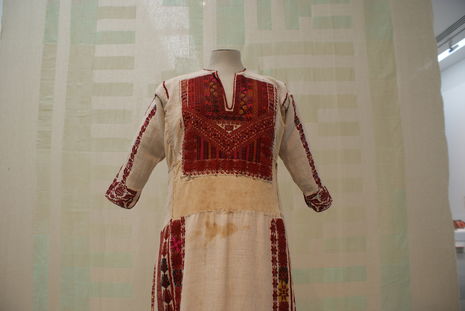
In contrast to the internal orientation of these elements of Material Power, the strength of Mediterranean Embroideries is in its focus on trade and exchange: in each embroidery, gallery text draws out the significance of thread colours or motifs to illustrate their spread across cultures. In a skirt border, distinctions between the typical red thread and an unexpected yellow thread are interpreted to show the haste of its completion and the material constraints of its design. In others, like a church vestment and a cushion cover (pictured below), evidence of repair and repurposing demonstrates the longevity of these works and their importance. Throughout Mediterranean Embroideries, we are encouraged to think about how motifs were given meaning and where those meanings originated.
Although less significant in Material Power, the political economy of embroidery does appear in Dedman’s analysis of changing materials and the commercialisation of embroidery. About late nineteenth and early twentieth century dresses, Dedman notes the influences of mass-produced fabrics and the appropriation of Palestinian patterns by European textile-producers. Interestingly, she also observes how these European interpretations were transmitted back to Palestine, where they changed the ongoing production of embroideries.
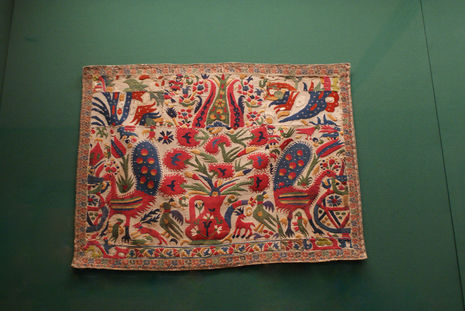
After this early example of Palestinian embroidery adjusting to a globalising society, Dedman draws attention to the formation of women’s committees and cooperatives in refugee camps that work to produce seemingly traditional embroideries for a mass market abroad. She emphasises how this process has also changed the relationship between producer and embroidery. Once the producer incorporated aspects of her identity in a dress’s motifs and materials and expected to wear it throughout her life; however, in commercially produced embroideries, her well-cultivated skills are now directed towards creating products that are less meaningful, by design.
“Material Power treads a careful path around the political questions of Palestinian nation- and statehood”
Discussing art produced amid conflict, Dedman’s Material Power treads a careful path around the political questions of Palestinian nation- and statehood. These complexities of reception have, no doubt, contributed to the decades-long period during which Palestinian embroidery had not been exhibited on its own in the United Kingdom. Nevertheless, Dedman has navigated these complexities cautiously, noting where conflict affected embroidery practice and where embroideries reflect the suffering of their Palestinian producers without allowing these issues to overshadow the everyday experience and practical dimensions of the craft.
Although tapestries, traditionally produced by men, have long been exhibited in museums and galleries within the tradition of Western fine art, embroideries and other textiles, more commonly produced by women, have not received such attention until recently. This increased attention is important to recognising the role of women in the history of art, not just today, but since antiquity. Textiles present a unique opportunity to write women back into the long history of art and to recognise the interplay of their work with other media. Both Mediterranean Embroideries and Material Power achieve these goals well by introducing the artistic production of women in the form of textile embroidery into larger narratives of cultural development and transnational conflict and exchange without losing sight of the political economies of gendered labour.
Mediterranean Embroideries will remain on display in the Shiba Gallery, Gallery 14 of the Fitzwilliam Museum until 22 October. Material Power: Palestinian Embroidery will remain on display at Kettle’s Yard until 29 October, with multiple events scheduled, before being displayed at the University of Manchester between 24 November 2023 and 7 April 2024.
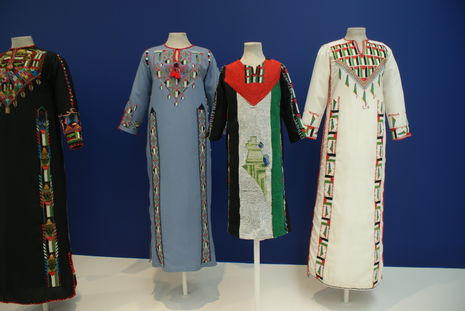
 News / Cambridge postgrad re-elected as City councillor4 May 2024
News / Cambridge postgrad re-elected as City councillor4 May 2024 News / Gender attainment gap to be excluded from Cambridge access report3 May 2024
News / Gender attainment gap to be excluded from Cambridge access report3 May 2024 News / Some supervisors’ effective pay rate £3 below living wage, new report finds5 May 2024
News / Some supervisors’ effective pay rate £3 below living wage, new report finds5 May 2024 Comment / Accepting black people into Cambridge is not an act of discrimination3 May 2024
Comment / Accepting black people into Cambridge is not an act of discrimination3 May 2024 News / Academics call for Cambridge to drop investigation into ‘race realist’ fellow2 May 2024
News / Academics call for Cambridge to drop investigation into ‘race realist’ fellow2 May 2024

